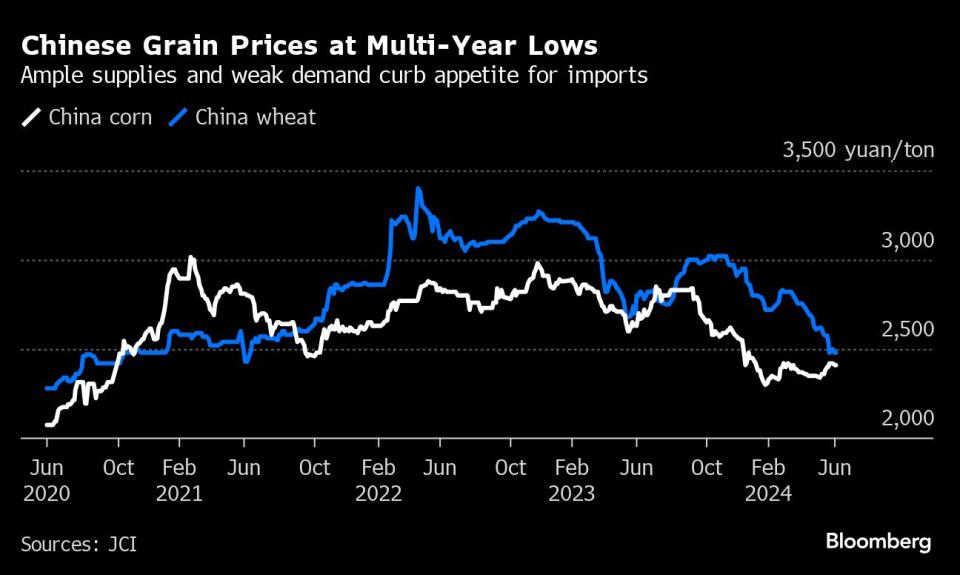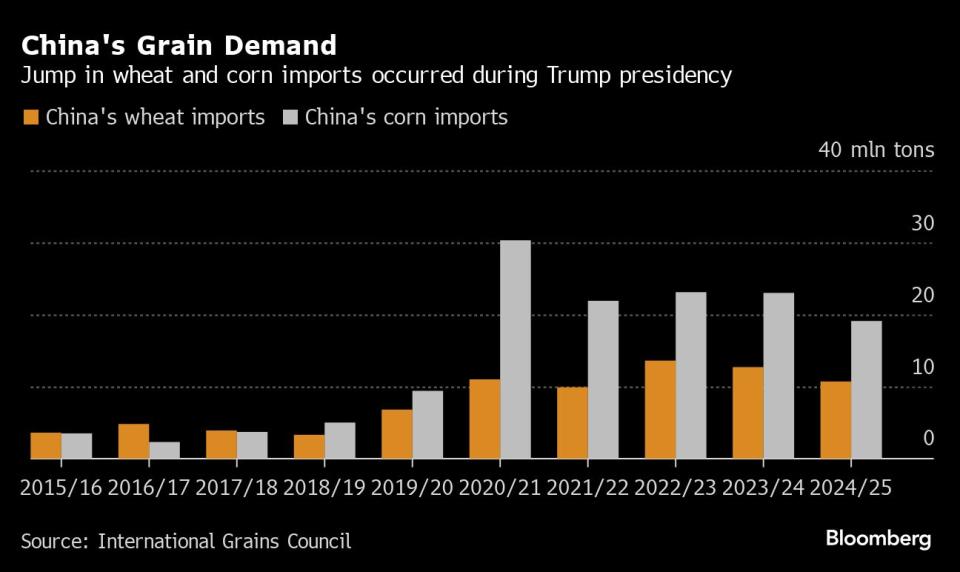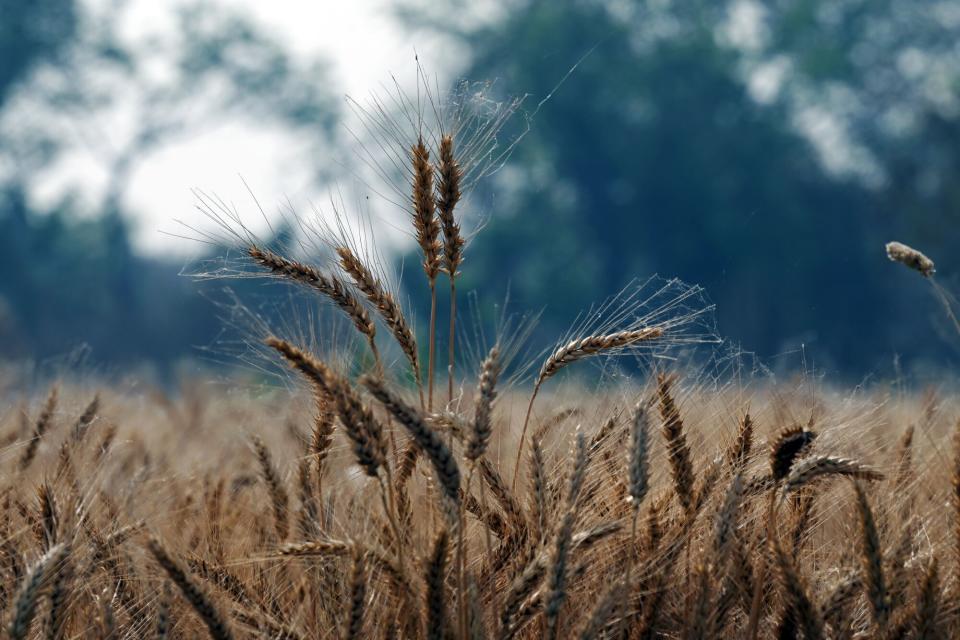China’s Waning Hunger for Grain Spells Trouble for World Market
(Bloomberg) -- China’s appetite for overseas wheat and corn is dwindling rapidly, which is likely to heap pressure on world grain markets that have grown accustomed to robust demand from the world’s top agricultural importer.
Most Read from Bloomberg
Buyers in China haven’t been observed making any major purchases for a couple of months, according to a number of traders. With domestic prices so low, that trend is likely to continue through the third quarter, they said, declining to be identified discussing sensitive commercial matters.
Global forecasters such as the International Grains Council and the US Department of Agriculture are still estimating hefty Chinese purchases over this year and next. If imports plunge, a key pillar of demand affecting farmers worldwide would be compromised.
China’s apathy over imports stems from a sluggish economy and consecutive bumper harvests. The government has been forced to stockpile both wheat and corn to support local farmers, while overseas corn shipments have been restricted or even canceled to prop up the domestic market.
That should alarm China’s foreign suppliers, particularly after Turkey, the world’s fifth biggest buyer of wheat, dealt a blow to demand last week by halting its imports of the grain for four months to shield local producers. Feeble consumption for similar reasons from China, the No. 2 importer, would only add to the market’s jitters.
“The economy is really bad, and overall demand from the whole of society is slumping,” said Ma Wenfeng, a senior analyst at BOABC, a consultancy in Beijing. “The government wants to raise grain prices and increase farm incomes, to activate demand in rural areas. Rather than buying grain from overseas, it is better to buy domestically.”
China has long been a massive buyer of soybeans, principally to nourish its vast hog herd, and is actively booking more cargoes. But the explosive growth in wheat and corn, which also count livestock feed among their uses, only began with diplomatic pledges made to the US during the trade war with the Trump administration.
Wheat and corn imports from January through April were actually running ahead of last year’s pace. That makes the sudden drop-off in activity all the more startling, and could leave international markets vulnerable to declines if China is indeed adjusting its strategy on overseas purchases.
In the last full week of May, the US had just 86,300 tons of corn left to ship to China in the current marketing year that ends in August, drastically below last year’s 631,600 tons, according to the USDA. For next season, there are no outstanding corn sales — which hasn’t happened in five years — and just 62,500 tons of wheat.
Although the situation could turn around swiftly, particularly in the event of bad weather affecting harvests, China’s glut of grain is unlikely to thin dramatically while consumption remains so weak. Moreover, another year of bumper wheat and corn production is on the cards.
Improved harvest conditions are likely to help narrow China’s wheat deficit from almost 17 million tons in this marketing year to under 7.5 million tons in 2024-25, resulting in reduced import demand, according to Charles Hart, senior commodities analyst at BMI, a unit of Fitch Solutions. Corn imports will also moderate in 2024-25 as output increases, he said.
Feed Demand
On the demand side, China’s pig herd is shrinking and meat consumption remains subdued. Mysteel Global expects animal feed requirements for the new wheat crop to shrink by half from a year ago, according to a report from the Chinese consultancy last week. Margins at mills that produce flour for cakes and bread are also suffering as people cut spending, Mysteel said.
That means fewer imports. For corn, China’s agriculture ministry has predicted that cargoes in the new marketing year will drop by a third to 13 million tons, from 19.5 million tons estimated for this year. The USDA is still holding out for 23 million tons, although it could revise its figure later Wednesday when it releases its monthly forecasts.
But there’s pressure on shipments to fall even further. China manages its imports according to a quota system that this year would allow just over 7 million tons of corn and nearly 10 million tons of wheat at the lowest tariff of 1%. After that, duties shoot up to 65%.
While buyers will be keen to use up their quotas, the economics of importing more than that makes much less sense, said BOABC’s Ma.
“We don’t need such big imports after all, given the bumper harvests and, more importantly, the significant declines in consumption,” he said.
On the Wire
China’s consumer prices rose in May, holding above zero for a fourth month after the country saw its worst deflation streak in over a decade.
Australia is realistic about the challenges in its diplomatic relationship with Beijing, Treasurer Jim Chalmers said, as the country prepares for the first visit by a Chinese premier in more than seven years.
A surprise tax change in Brazil, the world’s largest soybean exporter, is prompting Chinese buyers to snatch up US supplies.
This Week’s Diary
(All times Beijing unless noted.)
Wednesday, June 12:
China to release May aggregate financing & money supply by June 15
China’s inflation data for May, 09:30
CCTD’s weekly online briefing on Chinese coal, 15:00
China’s monthly CASDE crop supply-demand report
SNEC PV conference & exhibition in Shanghai, day 2
Thursday, June 13:
SNEC PV conference & exhibition in Shanghai, day 3
Friday, June 14:
China weekly iron ore port stockpiles
Shanghai exchange weekly commodities inventory, ~15:30
SNEC PV conference & exhibition in Shanghai, day 4
Most Read from Bloomberg Businessweek
China’s Economic Powerhouse Is Feeling the Brunt of Its Slowdown
As Banking Moves Online, Branch Design Takes Cues From Starbucks
Food Companies Hope You Won’t Notice Shortages Are Raising Prices
©2024 Bloomberg L.P.

 Yahoo Finance
Yahoo Finance 


